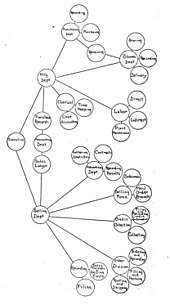
Chart of Business Organization, 1905.
Unity of Command in management and organization, is a term that defines the purpose of ensuring unity of effort under one responsible person (or commander) for completing a task.
Quotes
- Quotes are arranged alphabetically by author
A - F
- There is only a small number of principles and even these flow from a single, fundamental principle; ``Unity of Command.’’ In practice, the principal is as follows:
- Every action must be ordered by one person only or equally ``For any act the person who carries it out should receive orders from only one boss.’’
- Why should this be so? Why do all associations, all groups of men need one boss and one boss only? One could explain it as follows: it arises because of the near impossibility that two people have exactly the same feeling, the same point of view, the same conception of execution on any subject whatsoever: or equally, through a sense of justice which makes us desire that each person has responsibility for his actions and for his actions alone. And there are other considerations as well, but I will limit myself with the statement ``No one can serve two masters at the same time’’ says the proverb. And a popular saying adds, `Two people cannot both run the show.’’
- Henri Fayol (1908). "L’exposee des principles generaux d’administration". Unpublished paper, translated by J.D Breeze. published in: Daniel A. Wren, Arthur G. Bedeian, John D. Breeze, (2002) "The foundations of Henri Fayol’s administrative theory", Management Decision, Vol. 40 Iss: 9, pp.906 - 918
A - F
M - R
- Formal theories of organization have been taught in management courses for many years, and there is an extensive literature on the subject. The textbook principles of organization — hierarchical structure, authority, unity of command, task specialization, division of staff and line, span of control, equality of responsibility and authority, etc. — comprise a logically persuasive set of assumptions which have had a profound influence upon managerial behavior.
- Douglas McGregor (1960), The Human Side of Enterprise; p. 15. Annotated Edition, 2006, p. 21.
- Scalar principle: pyramid shape of an organization designed to control employees through a cascading network of of superiors and subordinates.
- Chain of command: the route that authority, responsibility, and communications travel within the hierarchy of an organization for the purpose of efficiency and order. For example, a captain orders a lieutenant to direct more preventive patrol to a certain neighborhood, or, alternatively, the lieutenant requests additional officers from the captain.
- Unity of command: subordinates should report to only one superior.
- Span of control: the number of subordinates that one superior can effectively supervise.
- Philip P. Purpura (1997), Criminal Justice: An Introduction, p. 171
S - Z
- Harold D. Koontz (1908–1984) and Cyril O’Donnell (1900–1976) of the University of California at Los Angeles defined management as "the function of getting things done through others." They furthered Fayol’s ideas and sought to provide a conceptual framework for the orderly presentation of the principles of management. According to Koontz and O’Donnell, managers were known by the work they performed, which was planning, organizing, staffing, directing, and controlling. These authors pointed out that, although some authorities maintained that these functions were exercised in the sequence given, in practice managers actually used all five simultaneously. They stressed that each of these functions contributed to organizational coordination. Coordination, however, was not a separate function itself but was the result of effective utilization of the five basic managerial functions. Koontz and O’Donnell offered a number of principles: in organizing, for example, "the principle of parity of authority and responsibility" and "the principle of unity of command"; in planning, "the principle of strategic factors"; and so on. The Koontz and O’Donnell text became an enduring, integral part of the search for a systematic body of management knowledge.
- Daniel A. Wren & Arthur G. Bedeian (2009). The evolution of management thought. p. 411-2
See also
External links
This article is issued from
Wikiquote.
The text is licensed under Creative
Commons - Attribution - Sharealike.
Additional terms may apply for the media files.